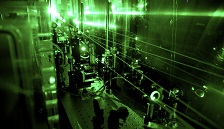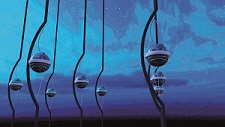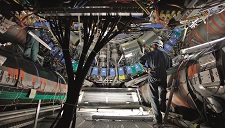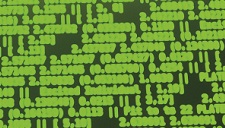The research program of PRISMA+ targets some of the most interesting aspects of modern particle, astroparticle and hadron physics. It consists of five research areas:

"The extraordinary high intensity of MESA provides the basis for high-precision measurements of natural constants and of the structure of subatomic particles. After all, the focus of our work is related to the great mysteries of the universe, such as the mysterious dark matter." Prof. Dr. Achim Denig
RA-A is devoted to exploiting the unique physics opportunities provided by the MESA accelerator and its experiments MAGIX, P2 and BDX@MESA. The P2 experiment will set a new precision standard for the measurement of the electroweak mixing angle at low energy and enable a new generation of experiments for parity-violating processes that are required for the determination of the neutron skin in heavy nuclei. The MAGIX spectrometer with its novel pseudo-internal gas-jet target will allow for a more accurate extraction of the proton charge radius via electron-proton scattering, as well as searches for messenger particles to the dark sector. The production of dark matter particles and the detection of their decay signatures will be pursued in the beam-dump experiment BDX@MESA. This is complementary to the direct searches for WIMP dark matter that forms the galactic halo.

"We place the Standard Model under scrutiny with our experiments. For this purpose, we need increasingly sophisticated technologies, which we successfully develop in Mainz. We create exotic atoms or trap particles so we can study them more closely than ever before." Prof. Dr. Randolf Pohl
Testing the Standard Model at low energies is the focus of RA-B. The main activities include a comprehensive study of the anomalous magnetic moment of the muon, the lifetime of the neutron, the charge radii of the proton and light nuclei, as well as searches for new physics via atomic parity violation. This research relies crucially on sophisticated experimental techniques that have been pioneered by PRISMA+ researchers, including laser spectroscopy of muonic and electronic atoms, magnetic trapping of neutrons, and the technique of initial state radiation at e+e- colliders. Another major focus is the reliable determination of hadronic contributions to the anomalous magnetic moment and charge radii.

"Neutrinos are ghost particles not easy to detect. However, we can catch them with our extremely massive detectors, providing us with an undisguised view on the processes in the sun’s core. Maybe neutrinos are close cousins of the mysterious particles making up dark matter?" Prof. Dr. Michael Wurm
RA-C focuses on the profound open questions related to neutrino masses and the existence of dark matter. The neutrino mass hierarchy and the absolute scale of neutrino masses will be addressed via crucial contributions to the JUNO, PINGU and Project 8 experiments. Searches for WIMPs will employ the world-leading XENONnT and DARWIN experiments. Highly innovative searches for axions and axion-like particles will be carried out at Mainz using the GNOME and CASPEr experiments, and through a leading involvement in the DM Radio experiment located at Stanford University.

"We work at huge particle accelerators all over the world, allowing us to investigate what happened in the early universe. For example, with the ATLAS detector at CERN we are studying the Higgs particle and with neutrino experiments in the US we want to understand why the universe contains so much more matter than antimatter." Prof. Dr. Volker Büscher
RA-D is devoted to indirect searches for new physics at the energy frontier. It brings together researchers from theory and a wide range of experiments to focus on solving major fundamental questions. The primary focus lies on the exploration of the deeper mechanism underlying electroweak symmetry breaking both at the LHC and at a future electron-positron collider. The relevant observables include the couplings of the Higgs boson, the mass of the W boson and a variety of diboson production rates. This program is complemented by searches for rare flavor-changing processes in the NA62 experiment at CERN and at the upcoming Belle II flavor factory. A third research direction is devoted to long-baseline neutrino experiments, whose main target is a measurement of CP violation in the lepton sector.

"We are working to better explain the inner structure of surrounding matter, using the methods of theoretical physics. We carry out our calculations with enormous computers and in doing so, deliver important contributions to the main research objectives of our colleagues who do experimental work." Prof. Dr. Stefan Weinzierl
The activities of RA-E are centered on advanced methods in quantum field theory, such as high-order perturbative calculations, applications of effective field theories, and new techniques in lattice gauge theory. Other important areas of research include physics beyond the SM, astroparticle physics, mathematical physics and string theory. PRISMA+ theorists not only work at the forefront of their respective fields but also provide the vigorous theory effort required to accomplish the key research objectives set out in this proposal.
theoretische Beiträge zu den Hauptforschungszielen der anderen Forschungsfelder.
They are supplemented by three key structural initiatives:
Mainz Energy-Recovering Superconducting Accelerator (MESA)
Mainz Institute for Theoretical Physics (MITP)
While these areas are largely grouped according to methodology and topical focus, they are closely interrelated in terms of the overall scientific objectives of the Cluster, since know-how and professional expertise from all areas complement and network each other. At the same time, scientists can take advantage from the unique environment and the existing infrastructure in Mainz.
